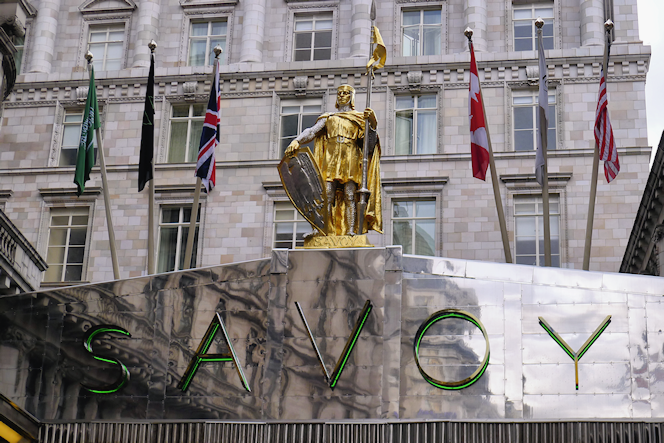Savoy
Savoy, Westminster
A compact precinct situated south of the Strand and west of Lancaster Place

In 1245 Henry III granted this place to his wife’s uncle, Peter, Count of Savoy, who built himself a palace here. After the count left in 1263 the Savoy Palace became the residence of Eleanor of Castile, wife of Prince Edward – who became Edward I in 1272. The palace was later given to Queen Eleanor’s second son, Edmund of Lancaster. In the latter part of the 14th century it was the residence of John of Gaunt, who virtually ruled England from here for several years.
Most of the original buildings were destroyed by Wat Tyler’s followers during the Peasants’ Revolt in 1381, but Henry VII bequeathed funds for the reconstruction of the palace as a home for the poor, which was named St John’s Hospital. It became a military hospital, then a barracks under Charles II.
A chapel was built within the Savoy precinct in 1505-12 and, after the destruction of St Mary le Strand by Edward Seymour, it became known as St Mary le Savoy. The chapel remains an important part of the Savoy estate, the Duchy of Lancaster’s principal London landholding. Members of the public are welcome to attend services in what is now the Queen’s Chapel of the Savoy.
In the late 17th century the Savoy precinct became a notorious place of sanctuary for desperadoes and outlaws, who were nicknamed ‘Savoyards’ – a term originally applied to natives of Savoy in France. (Later, the word was used for performers in, or devotees of, the Savoy operas – see below.)
Except for the chapel, the old Savoy buildings were demolished with the construction of John Rennie’s Waterloo Bridge, which was completed in 1831.

In 1881 the impresario Richard D’Oyly Carte built the Savoy Theatre to stage his productions of the Gilbert and Sullivan operettas. It opened with Patience, which transferred from another theatre, and the first original production here was Iolanthe in 1882. The theatre is now part of the Ambassador group and presents modern, musical-based productions.
The success of the Savoy operas enabled D’Oyly Carte to commission the construction of the Savoy hotel, on the site of the former Savoy Palace. Its first manager was César Ritz (who went on to found the Ritz hotel) and its first chef was Auguste Escoffier, who created the Peach Melba here in honour of Dame Nellie Melba’s visit in 1892.
In 1898 the Savoy acquired Simpson’s‑in-the-Strand, which had evolved from a chess club and coffee house into London’s best-known restaurant for traditional British fare, especially a roast beef dinner.
The restaurant’s original buildings were demolished when the Strand was widened in 1903 and Simpson’s was rebuilt as part of the complex linked to the hotel.
In 1923 the BBC established its first studios in an office block on Savoy Hill. The building, which is now called Savoy Hill House, remained the BBC’s headquarters until 1932.
A consortium headed by Prince Al-Waleed bin Talal bought the Savoy hotel in 2005 and awarded the management contract to Fairmont Hotels and Resorts. In December 2007 the hotel closed in order to undergo a lavish restoration that took almost three years to complete. Some of the Savoy’s historic memorabilia are now on display in a small museum space located left of the entrance to the American Bar.
Arnold Bennett’s Imperial Palace (1930), his last and longest novel, is set in the Savoy hotel.
The hotel features as the place of punishment of ‘Godolphin Horne’, the subject of one of Hilaire Belloc’s Cautionary Tales for Children (1907) and a well-born child who is beset by the sin of pride: “So now Godolphin is the Boy / Who blacks the Boots at the Savoy.”
